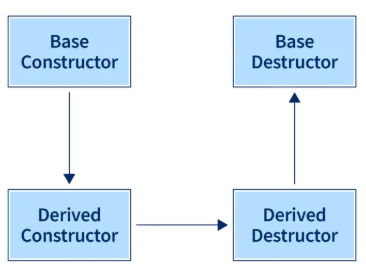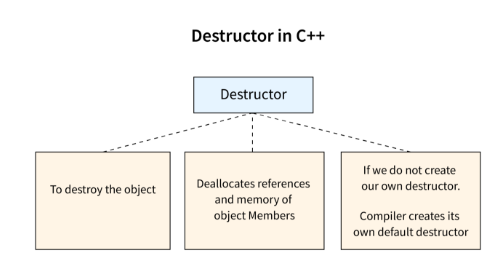
- What is a Destructor?
- Syntax and Declaration Rules
- Destructor vs Constructor
- Automatic Invocation of Destructors
- Order of Destructor Calls
- Destructor in Inheritance
- Virtual Destructors
- Conclusion
What is a Destructor?
A destructor in C++ is a special member function that gets invoked automatically when an object goes out of scope or is explicitly deleted. Its primary role is to clean up resources that the object may have acquired during its lifecycle such as dynamic memory, file handles, network sockets, or database connections. A destructor helps implement the RAII (Resource Acquisition Is Initialization) principle, which ensures resource release as part of object destruction. By defining destructors properly, developers can avoid common issues like memory leaks, dangling pointers, and resource exhaustion.A destructor is a special member function in C++ that is automatically invoked when an object goes out of scope or is explicitly deleted Web Designing & Development Training . Its primary purpose is to free resources that the object may have acquired during its lifetime, such as dynamically allocated memory, file handles, or network connections. The destructor ensures that an object is properly cleaned up, preventing memory leaks and other resource mismanagement issues. In C++, a destructor has the same name as the class but is preceded by a tilde ~ symbol. For example, a class named MyClass will have a destructor named ~MyClass(). Unlike constructors, destructors do not take parameters and do not return any value, not even void. A class can have only one destructor, and it cannot be overloaded. Destructors are particularly important in programs that manage dynamic memory or other system resources, especially in embedded systems or performance-critical applications. In the case of inheritance, destructors should be declared virtual in base classes to ensure that the correct destructor is called for derived objects, enabling proper resource deallocation through base class pointers. Overall, destructors play a critical role in resource management, making C++ a powerful language for building reliable and efficient software systems.
To Earn Your Web Developer Certification, Gain Insights From Leading Data Science Experts And Advance Your Career With ACTE’s Web Developer Courses Today!
Syntax and Declaration Rules
The syntax of a destructor is quite similar to that of a constructor but with a few key differences Software Developer vs Software Engineer. A destructor:
- Is declared with a tilde ~ followed by the class name
- Has no return type (not even void)
- Takes no arguments
- Cannot be overloaded or inherited directly
- class MyClass {
- public:
- ~MyClass(); // Destructor declaration
- };
- MyClass::~MyClass() {
- cout << "Destructor called." << endl;
- }
C++ ensures that destructors are always called when an object goes out of scope or is deleted, making cleanup automatic and safe.
Destructor vs Constructor
constructor
- Definition: A constructor is a special function that is automatically called when an object is created.
- Purpose: Used to initialize objects (assign initial values, allocate resources, etc.).
- Name: Same as the class name (no return type).
- Types:
- Default constructor
- Parameterized constructor
- Copy constructor
- Overloading: Become an IT Engineer, Can be overloaded to allow different ways of initializing objects.
- Automatic Call: Called automatically when an object is created.
- Definition: A destructor is a special function that is automatically called when an object is destroyed.
- Purpose: Used to clean up resources (free memory, close files, etc.).
- Name: Web Designing & Development Training Same as the class name but prefixed with a tilde ~.
- Types: Only one destructor per class (no overloading).
- No Parameters: A destructor cannot take arguments.
- Automatic Call: Called automatically when the object goes out of scope or is deleted.
- class A {
- public:
- A() { cout << "Constructor A\n"; }
- ~A() { cout << "Destructor A\n"; }
- };
- class B {
- public:
- B() { cout << "Constructor B\n"; }
- ~B() { cout << "Destructor B\n"; }
- };
- int main() {
- A a;
- B b;
- return 0;
- }
- Constructor A
- Constructor B
- Destructor B
- Destructor A
- class Base {
- public:
- Base() { cout << "Base constructor\n"; }
- ~Base() { cout << "Base destructor\n"; }
- };
- class Derived : public Base {
- public:
- Derived() { cout << "Derived constructor\n"; }
- ~Derived() { cout << "Derived destructor\n"; }
- };
- int main() {
- Derived d;
- return 0;
- }
- Base constructor
- Derived constructor
- Derived destructor
- Base destructor
- class Base {
- public:
- virtual ~Base() {
- cout << "Base Destructor\n";
- }
- };
- class Derived : public Base {
- public:
- ~Derived() {
- cout << "Derived Destructor\n";
- }
- };
- int main() {
- Base* ptr = new Derived();
- delete ptr;
- return 0;
- }
- Derived Destructor
- Base Destructor

destructor
Would You Like to Know More About Web Developer? Sign Up For Our Web Developer Courses Now!
Automatic Invocation of Destructors
In Destructor in C++, destructors are automatically invoked when an object goes out of scope or is explicitly deleted. This automatic invocation is a key feature of the language’s resource management capabilities, helping ensure that objects clean up after themselves without requiring manual intervention from the programmer. For instance, when a local object inside a function ends its lifetime as the function returns, its destructor is automatically called to release any resources it holds. Similarly, IT Engineer Salary in India when a dynamically allocated object is deleted using the delete keyword, the destructor is executed before the memory is deallocated. This mechanism is especially important in complex programs that allocate memory, open files, or acquire system resources. It helps prevent memory leaks and other resource-related bugs. In cases of class inheritance, destructors should be declared as virtual in base classes to ensure that the correct derived class destructor is called when an object is deleted through a base class pointer. Without a virtual destructor, only the base class destructor would execute, potentially leaving derived class resources unreleased. The automatic invocation of destructors makes C++ well-suited for applications where deterministic resource cleanup is necessary, such as embedded systems, real-time applications, and systems programming.
Order of Destructor Calls
When multiple objects are created in a function, destructors are called in the reverse order of object construction Best Software Development Courses . This is known as LIFO (Last In, First Out) order.

Output:
Are You Interested in Learning More About Web Developer? Sign Up For Our Web Developer Courses Today!
Destructor in Inheritance
In Destructor in Inheritance, destructors are called in the order from the most derived class back to the base class. Complete Guide on System Software, This guarantees that resources of derived classes are cleaned up first before the base class releases its resources.
Output:
Virtual Destructors
Virtual destructors ensure that if a derived class object is deleted via a base class pointer, the derived class’s destructor is also called. Without a virtual destructor Backend Development , only the base class destructor is invoked, which may lead to resource leaks.
Output:
Always declare destructors as virtual in base classes if they are intended to be inherited from.
Conclusion
Hierarchical inheritance in C++ is a powerful and elegant feature that simplifies the representation of systems where multiple entities share common behaviors. It not only helps in reducing code duplication but also enhances maintainability and scalability. By understanding how constructors, destructors, access modifiers, and virtual functions work in this context, Web Designing & Development Training can write more efficient and robust object-oriented applications. The key to Advantages of Hierarchical Inheritance lies in thoughtful class design identifying shared functionalities early, properly applying inheritance hierarchies, and making use of access specifiers and polymorphism. With practice and real-world projects, developers can leverage this concept to build clean, modular, and well-structured software systems.





